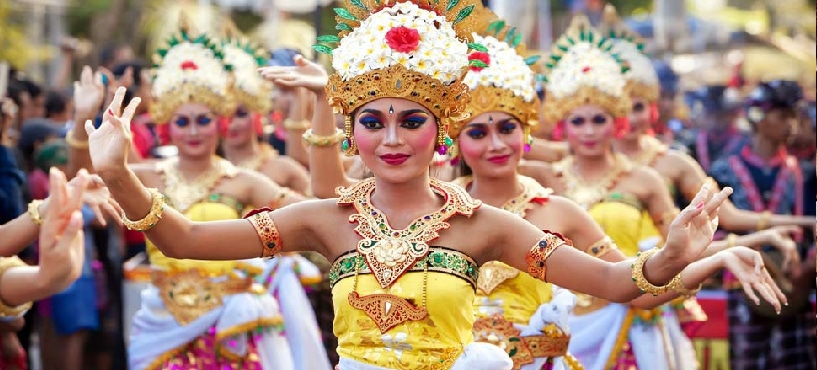Introduction:
Bali, often called the “Island of the Gods,” is renowned not just for its stunning landscapes but also for its rich and vibrant culture. This unique cultural heritage is deeply rooted in Hindu traditions and is expressed through various art forms, rituals, and daily practices. In this comprehensive guide, we will explore the captivating culture of Bali, highlighting its key elements and providing insight into how visitors can respectfully engage with and appreciate this cultural richness.
Section 1: Balinese Hinduism
Overview of Balinese Hinduism
Bali is predominantly Hindu, unlike the rest of Indonesia, which is primarily Muslim. Balinese Hinduism is a unique blend of Indian Hinduism and indigenous Balinese beliefs. It emphasizes the balance between the physical and spiritual worlds, and this philosophy is reflected in daily life, ceremonies, and temple architecture.
Key Beliefs and Practices
- Tri Hita Karana: The principle of living in harmony with God, people, and nature. This concept is central to Balinese culture and influences everything from agriculture to social interactions.
- Offerings (Canang Sari): Daily offerings made to appease spirits and maintain balance. These small, woven baskets filled with flowers, rice, and incense are placed in temples, homes, and businesses.
- Nyepi: The Balinese Day of Silence, marking the New Year. On this day, the island shuts down completely—no flights, no traffic, and even electricity use is minimized. It’s a day of introspection and meditation.
Section 2: Traditional Arts and Performances
Dance and Drama
Balinese dance and drama are integral parts of the island’s cultural expression. These performances are not merely entertainment but are imbued with religious significance, telling stories from Hindu epics like the Ramayana and Mahabharata.
Key Performances
- Barong and Rangda: A traditional dance depicting the eternal battle between good (Barong) and evil (Rangda). It’s a powerful performance filled with elaborate costumes and dynamic movements.
- Legong Dance: Known for its intricate finger movements and expressive gestures, the Legong dance is performed by young girls in lavish costumes, often recounting tales of love and heroism.
- Kecak Dance: A captivating dance performed by a group of men chanting “cak” in unison, enacting scenes from the Ramayana. It’s performed around a fire, creating a mesmerizing atmosphere.
Section 3: Balinese Craftsmanship
Traditional Crafts
Bali is famous for its skilled artisans and craftsmen. Traditional crafts such as woodcarving, stone carving, painting, and weaving are not only important economically but also culturally, as they often depict religious themes and motifs.
Notable Craft Centers
- Ubud: Known as the artistic heart of Bali, Ubud is home to numerous galleries, workshops, and markets where visitors can observe and purchase traditional Balinese art and crafts.
- Celuk: A village renowned for its silver and goldsmiths. Here, you can find intricate jewelry and metalwork that showcase the exquisite craftsmanship of Balinese artisans.
- Mas: Famous for its woodcarving, Mas is the place to find beautifully carved statues, masks, and furniture, reflecting the island’s artistic heritage.
Section 4: Balinese Cuisine
Unique Flavors
Balinese cuisine is a reflection of the island’s cultural diversity and agricultural abundance. The food is characterized by bold flavors, aromatic spices, and fresh ingredients. Traditional Balinese dishes are often served during ceremonies and communal gatherings, emphasizing the importance of food in social and religious contexts.
Must-Try Dishes
- Babi Guling: Spit-roasted pig, marinated with a blend of traditional spices and herbs, often served during special occasions and ceremonies.
- Lawar: A traditional mix of vegetables, coconut, and minced meat, flavored with rich herbs and spices, sometimes including blood for authenticity.
- Nasi Campur: A mixed rice dish with small portions of various meats, vegetables, peanuts, eggs, and fried-shrimp krupuk. It’s a popular and versatile dish enjoyed by locals and visitors alike.
Section 5: Cultural Etiquette
Respecting Traditions
When visiting Bali, it’s important to respect local customs and traditions. Understanding and adhering to cultural etiquette not only enhances your experience but also shows respect to the local community.
Key Etiquette Tips
- Dressing Modestly: When visiting temples or rural areas, dress modestly by covering your shoulders and knees. Wearing a sarong and sash is recommended when entering temples.
- Temple Etiquette: Always show respect in temples by speaking softly, not pointing your feet towards shrines, and not climbing on statues or structures.
- Social Interactions: Use your right hand for giving and receiving items, and avoid touching people’s heads, as it is considered the most sacred part of the body.
Conclusion:
The culture of Bali is a rich tapestry woven with religious beliefs, artistic expressions, and deep-rooted traditions. By understanding and respecting this culture, visitors can gain a deeper appreciation of what makes Bali so unique and enchanting. Whether you are exploring the intricate dances, indulging in traditional cuisine, or marveling at the craftsmanship, engaging with Bali’s culture will undoubtedly enrich your travel experience and leave you with lasting memories of this magical island.





